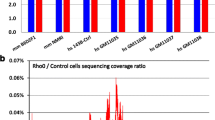Abstract
Molecular haplotyping is becoming increasingly important for studying the disease association of a specific allele because of its ability of providing more information than any single nucleotide polymorphism (SNP). Computational analysis and experimental techniques are usually performed for haplotypic determination. However, established methods are not suitable for analyzing haplotypes of massive natural DNA samples. Here we present a simple molecular approach to analyze haplotypes of conventional polymerase chain reaction (PCR) products quantitatively in a single sequencing run. In this approach, specific types and proportions of haplotypes in both individual and pooled samples could be determined by solving equations constructed from nonsynchronous pyrosequencing with di-base addition. Two SNPs (rs11176013 and rs11564148) in the gene for leucine-rich repeat kinase 2 (LRRK2) related to Parkinson’s disease were selected as experimental sites. A series of DNA samples, including these two heterozygous loci, were investigated. This approach could accurately identify multiple DNA samples indicating that the approach is likely to be applied for haplotyping of unrestricted conventional PCR products from natural samples, and be especially applicable for analyzing short sequences in clinical diagnosis.

One DNA sample consisting of 4 different DNA templates with different proportion are sequenced by nonsynchronous pyrosequencing with di-base addition. The number of incorporated nucleotides produced by a single sequencing reaction equals to the total of incorporated nucleotides. Four independent equations are constructed from the pyrograms of nonsynchronous pyrosequencing data. Molecular haplotypes of two adjacent SNPs can be quantitatively identified by solving these equations.



Similar content being viewed by others
References
Judson R, Stephens JC, Windemuth A. The predictive power of haplotypes in clinical response. Pharmacogenomics. 2000;1:15–26.
Johnson GC, Esposito L, Barratt BJ, Smith AN, Heward J, Di Genova G, et al. Haplotype tagging for the identification of common disease genes. Nat Genet. 2001;29:233–7.
Wang Y, Liu H, Ready NE, Su L, Wei Y, Christiani DC, et al. Genetic variants in ABCG1 are associated with survival of nonsmall-cell lung cancer patients. Int J Cancer. 2016;138:2592–601.
Wu YR, Chang KH, Chang WT, Hsiao YC, Hsu HC, Jiang PR, et al. Genetic variants of LRRK2 in Taiwanese Parkinson’s disease. PLoS One. 2013;8:11–4.
Guo J-F, Li K, Yu R-L, Sun Q-Y, Wang L, Yao L-Y, et al. Polygenic determinants of Parkinson’s disease in a Chinese population. Neurobiol Aging. 2015;17:1–6.
Klonoff DC. Precision medicine for managing diabetes. J Diabetes Sci Technol. 2015;9:3–7.
Aronson SJ, Rehm HL. Building the foundation for genomics in precision medicine. Nature. 2015;526:336–42.
Browning SR, Browning BL. Haplotype phasing: existing methods and new developments. Nat Rev Genet. 2011;12:703–14.
Pettersson M, Bylund M, Alderborn A. Molecular haplotype determination using allele-specific PCR and pyrosequencing technology. Genomics. 2003;82:390–6.
Yan H, Papadopoulos N, Marra G, Perrera C, Jiricny J, Boland CR, et al. Conversion of diploidy to haploidy. Nature. 2000;403:723–4.
Ruano G, Kidd KK, Stephens JC. Haplotype of multiple polymorphisms resolved by enzymatic amplification of single DNA molecules. Proc Natl Acad Sci U S A. 1990;87:6296–300.
MichalatosBeloin S, Tishkoff SA, Bentley KL, Kidd KK, Ruano G. Molecular haplotyping of genetic markers 10 Kb apart by allele-specific long-range PCR. Nucleic Acids Res. 1996;24:4841–3.
Zhou H, Li S, Liu X, Wang J, Luo Y, Hickford JGH. Haplotyping using a combination of polymerase chain reaction-single-strand conformational polymorphism analysis and haplotype-specific PCR amplification. Anal Biochem. 2014;466:59–64.
Stephens JC, Rogers J, Ruano G. Theoretical underpinning of the single-molecule-dilution (SMD) method of direct haplotype resolution. Am J Hum Genet. 1990;46:1149–55.
Paul P, Apgar J. Single-molecule dilution and multiple displacement amplification for molecular haplotyping. Biotechniques. 2005;38:553–9.
Ahmadian A, Gharizadeh B, Gustafsson AC, Sterky F, Nyrén P, Uhlén M, et al. Single-nucleotide polymorphism analysis by pyrosequencing. Anal Biochem. 2000;280:103–10.
Zhou G, Kamahori M, Okano K, Chuan G, Harada K, Kambara H. Quantitative detection of single nucleotide polymorphisms for a pooled sample by a bioluminometric assay coupled with modified primer extension reactions (BAMPER). Nucleic Acids Res. 2001;29, E93.
Odeberg J, Holmberg K, Eriksson P, Uhlén M. Molecular haplotyping by pyrosequencing. Biotechniques. 2002;33:1104–8.
Pu D, Mao C, Cui L, Shi Z, Xiao P. Pyrosequencing with di-base addition for single nucleotide polymorphism genotyping. Anal Bioanal Chem. 2016;408:3113–23.
Pu D, Qi Y, Cui L, Xiao P, Lu Z. A real-time decoding sequencing based on dual mononucleotide addition for cyclic synthesis. Anal Chim Acta. 2014;852:274–83.
Andalib S, Vafaee MS, Gjedde A. Parkinson’s disease and mitochondrial gene variations: a review. J Neurol Sci. 2014;346:11–9.
Gao J, Li YY, Sun PN, Shen L. Comparative analysis of dideoxy sequencing, the KRAS StripAssay, and pyrosequencing for detection of KRAS mutation. World J Gastroenterol. 2010;16:4858–64.
Acknowledgment
The work was funded by the National Natural Science Foundation of China (61571114).
Author information
Authors and Affiliations
Corresponding author
Ethics declarations
The authors declare that the experiments comply with the current laws of the country and written informed consent was obtained from all volunteers.
Conflict of interest
The authors declare that they have no conflict of interest.
Electronic supplementary material
Below is the link to the electronic supplementary material.
ESM 1
(PDF 183 kb)
Rights and permissions
About this article
Cite this article
Pan, R., Xiao, P. Quantitative haplotyping of PCR products by nonsynchronous pyrosequencing with di-base addition. Anal Bioanal Chem 408, 8263–8271 (2016). https://doi.org/10.1007/s00216-016-9936-7
Received:
Revised:
Accepted:
Published:
Issue Date:
DOI: https://doi.org/10.1007/s00216-016-9936-7




